|
Actually, I had driven to the temple Saturday night, hoping to catch the scheduled Vishnu Sahasranama Ashtotam. However, I arrived (which was well after the beginning of the service), to fall into a line of cars leading into the sanctuary's parking lot. The lot was quite small, and the need for spaces was so great, I figured that if I did get a spot, I'd be taking it from someone who might really need to be there. So, I returned home. On my return the next afternoon, the parking lot was full, but not overflowing, and I found a spot quickly. On the outside, the building was surprisingly modest in those design elements that might give one a clue to its purpose. I didn't even notice a sign by the road as I was coming in. The mandir's entrance area had tables to the left and right of the doors, laden with various things: a schedule of upcoming religious events, announcements of concerts and other items of interest to the Hindu community, and advertisements of businesses of interest, such as where one could get custom-made Hindu women's clothing. The foyer was modern and utilitarian in design. Signs on the right of the heavy wooden doors leading to the sanctuary pointed to the shoe and coat rooms, and on the left was an unmanned information desk, with a sign inviting one to ask if there were questions or comments. Another sign next to the desk had information about a concert that was in progress; I could hear the faint sounds of the music. I went to the shoe rooms and removed my shoes. I read one last sign before entering the sanctuary. It asked for silence when in the temple. I opened the doors and passed under an overhead of hanging flowers, and was at once signaled to the sanctity of the environment by the smell of sandalwood incense. That was going to be a problem - I am allergic to sandalwood, and I wondered how long I would be able to stay before the migraine headache would begin. Brushing the thought aside, I viewed a large area, brightly lit not only from lights, but several floor to ceiling windows on the left and right of the temple area, between niches where statues of many of the principal Hindu deities sat. The main area of the floor was carpeted, with a border of white stone at the perimeter. The ceiling center of the area rose up several steps. The walls were splashed here and there with a lovely shade of light pink paint, and there were two principle columns toward the back adorned with swastikas. A few chairs were scattered around the perimeter. The back of the temple area had four large separate areas where groupings of Hindu deities were sitting in state, and strings of lights were hung over each area. A group of Hindus were gathered over to the far left of the area, sitting on white sheets that had been laid on the carpet. A priest was chanting for them. Beginning on my right, I walked over to two backlit niches of Jain statues: they were the 23rd and
The back central area was constructed with several steps up, leading to "altar" areas that contained principle Hindu deities. From my right, the first group was Vishnu and Lakshmi, then the Ram-Darbar, then Shiva, Parvati and Ganesha, and the last, and noticeably larger than the others, was the Durga (and was nearest where the priest and the group previously mentioned were assembled). These groupings were nothing short of radiant: dressed in bright colors with gold jewelry and headdresses. A line of velvet roping kept worshippers from touching them, and plates of food offerings were all around.
Taking a chair toward the back of the temple, I sat and watched what went on around me. Many people drifted in to pray at one or more of the deity statues. Some would approach the deity, kneel, and touch their head to the floor. Others would put their hands together in prayer, touch their folded hands to their foreheads, and then touch the base of the niche. Still others would begin with the prayerful pose, then reverently and delicately touch the statue itself, then bring their hands to their face and body as if they were "washing" themselves with deity energy. Many people added money to one or more of the collection boxes placed beneath each deity. Mothers would make rounds with their children; some children would make the rounds alone and with all the reverence of some of their adult counterparts. Those that passed me would turn and smile. While all of the men were dressed in typical "American" clothing, most of the women and female children were dressed in the deeply colored, flowing dresses of Hindu women.
The couple gave the priest a bowl and several large, zinnia-like flowers. He opened the bowl, and poured the liquid - milk! - in another bowl in front of a small Ganesha that was with the statues of Shiva and Parvati. The priest then placed one of the flowers on the Parvati, then touched another to all three of the statues and then gave the flower back to the couple, along with a banana and a pear. It was then that I was pleasantly surprised by the generosity and ecumenical spirit of one of the women from the Durga prayer group. I noticed her handing out warm food to people at various deity "stations" throughout the sanctuary. Remembering what we had learned in class about food offerings to the gods that were then given to others (prasad), I looked down to my notebook to make a note of it. When I looked up again, she was patiently waiting in front of me, and asked if I would like some! I think if it had been any of the other deities, I might have said no. But, since the Durga is so much like one of my own goddesses, I smiled and humbly accepted. I had hoped to get some time to speak with the priest, but the sandalwood was unpleasantly beginning to make its presence known to me. I went to the shoe room, donned my shoes, and left the mandir. Driving away, I reflected on the time I spent in the mandir. Never once did I feel out of place. Not once did I get the impression from anyone that I didn't belong. On the contrary, I felt most welcomed. The atmosphere of the temple was calm and loving, and I felt the layout of the sanctuary was as much to encourage a communal community environment, as it was to seat a large group of people. I was honored to have had the experience. It was one that I will not forget. |
| Created by Laura Ellen Shulman |
Last updated: March 06, 2005
|
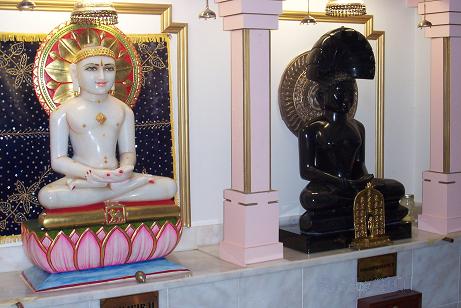 24th
Tirthankaras, Parshvanath (all black) and Mahavir (white with cosmetic coloring), respectively. A sign was posted between the two, but it was in Hindu. I knew from the temple's Web site that a sign was once there, but in English, and it asked that no food or offerings be left. Next was a smaller, framed painting of a bearded man sitting in a lotus position. The frame was adorned with a flower chain and a small table in front of it held a candlestick-like object with 4 or 5 wicks and an incense burner. I got the feeling the picture may be of an important guru.
24th
Tirthankaras, Parshvanath (all black) and Mahavir (white with cosmetic coloring), respectively. A sign was posted between the two, but it was in Hindu. I knew from the temple's Web site that a sign was once there, but in English, and it asked that no food or offerings be left. Next was a smaller, framed painting of a bearded man sitting in a lotus position. The frame was adorned with a flower chain and a small table in front of it held a candlestick-like object with 4 or 5 wicks and an incense burner. I got the feeling the picture may be of an important guru.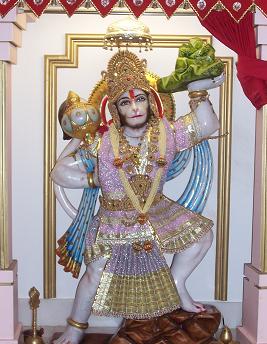
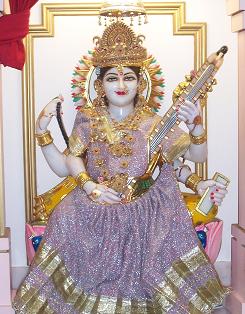 Past the bank of windows was another set of side niches, and the first one held
Hanuman, the Hindu monkey god. The statue, as all the others, was wonderfully colored, and his face held a benevolent countenance. Next was a sitting statue of Saraswati, holding her musical instrument, in brightly colored garb and, like the other statues, was adorned with necklaces and other appliances of gold.
Past the bank of windows was another set of side niches, and the first one held
Hanuman, the Hindu monkey god. The statue, as all the others, was wonderfully colored, and his face held a benevolent countenance. Next was a sitting statue of Saraswati, holding her musical instrument, in brightly colored garb and, like the other statues, was adorned with necklaces and other appliances of gold.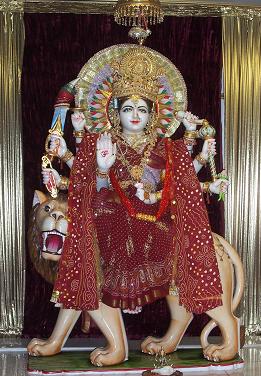
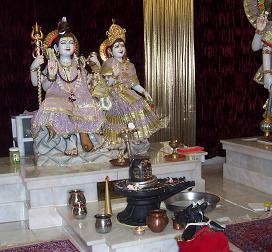
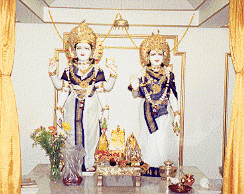
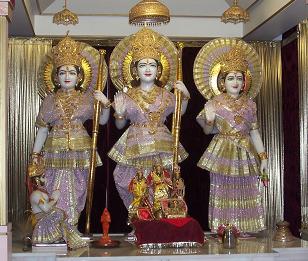
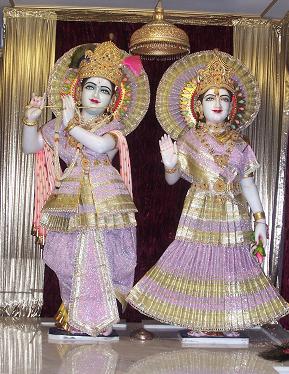
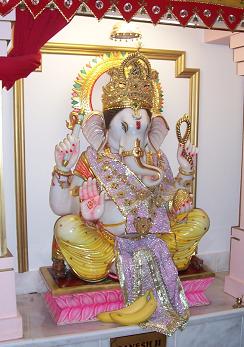 On the wall, left from the main altar area, were more niches. There were two black statues, one with a feline-headed framing (Bala). Past the banks of windows on that side were three last niches. The first of those held the framed picture of a smiling young man, sitting on a throne adorned with gold. He was Lord Ayyappa. Next to him was a black statue that was sitting on a peacock and holding a scepter. The mandir's Web site lists him as Balasubramanyam. Lastly was the statue of Ganesha, dressed in a blue robe with gold trim.
On the wall, left from the main altar area, were more niches. There were two black statues, one with a feline-headed framing (Bala). Past the banks of windows on that side were three last niches. The first of those held the framed picture of a smiling young man, sitting on a throne adorned with gold. He was Lord Ayyappa. Next to him was a black statue that was sitting on a peacock and holding a scepter. The mandir's Web site lists him as Balasubramanyam. Lastly was the statue of Ganesha, dressed in a blue robe with gold trim.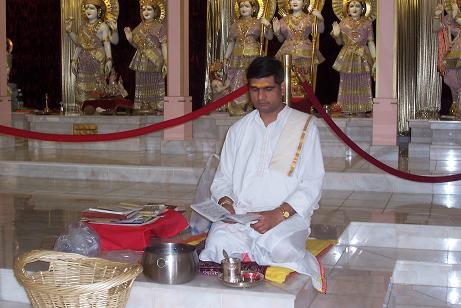 The group that was chanting at the foot of the Durga had stopped. The priest then handed a bowl to another man in the group, and I heard a deep, resonating, "Om" from his lips. He then launched into prayer as well. Several minutes later he stopped, and the priest lit a small lamp, and went to each person in the group, one by one, and each would take their hands, begin behind the flame, pass their hands through the top of the flame, and "wash" themselves with it. Mothers would do so twice - one for the child they held. The priest then took the flame and placed it to the side of the Durga statue. The prayer group was finished, and after many of the people respectfully bent to either kiss or press their foreheads to the hem of the priest's white and gold garb, the priest moved on to speak with another couple that was patiently waiting for him.
The group that was chanting at the foot of the Durga had stopped. The priest then handed a bowl to another man in the group, and I heard a deep, resonating, "Om" from his lips. He then launched into prayer as well. Several minutes later he stopped, and the priest lit a small lamp, and went to each person in the group, one by one, and each would take their hands, begin behind the flame, pass their hands through the top of the flame, and "wash" themselves with it. Mothers would do so twice - one for the child they held. The priest then took the flame and placed it to the side of the Durga statue. The prayer group was finished, and after many of the people respectfully bent to either kiss or press their foreheads to the hem of the priest's white and gold garb, the priest moved on to speak with another couple that was patiently waiting for him.